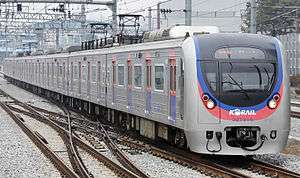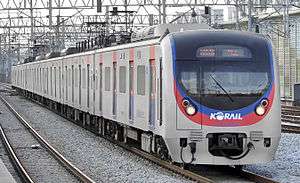Gyeongui–Jungang Line
The Gyeongui–Jungang Line is a commuter rail service of the Seoul Metropolitan Subway system, operating on trackage from the Gyeongui Line (opened on July 1, 2009) and the Jungang Line (opened on December 16, 2005).[1]
| Gyeongui–Jungang Line | |
|---|---|
 | |
| Overview | |
| Native name | 경의·중앙선(京義·中央線) Gyeongui-Jungang-seon |
| Type | Commuter rail |
| System | Seoul Metropolitan Subway |
| Status | Operational |
| Termini | Munsan (most trains) or Imjingang (select trains) Yongmun (most trains) or Jipyeong or Seoul (select trains) |
| Stations | 53 |
| Operation | |
| Opened | 27 December 2014 |
| Operator(s) | Korail |
| Depot(s) | Munsan Depot, Yongmun Depot |
| Rolling stock | Korail Class 321000 (21 trains) Korail Class 331000 (27 trains) |
| Technical | |
| Line length | 134 km (83 mi) |
| Number of tracks | 2 (Munsan–Neunggok, Gajwa–Jipyeong, Gajwa–Seoul) 4 (Neunggok–Gajwa) |
| Track gauge | 1,435 mm (4 ft 8 1⁄2 in) |
| Electrification | 25 kV AC 60 Hz |
Frequent service is provided between Munsan and Yongmun by 8-car trains, with 4 trains a day running one station east of Yongmun to Jipyeong. However, some services (run by 4-car trains) split for Seoul Station east of Gajwa. Additionally, many trains terminate at various locations on the line such as Ilsan, Neunggok, Daegok, Yongsan, Cheongnyangni, Deokso, and Paldang.
Trains travel along the Gyeongui (Munsan-Seoul Station/Gajwa), Yongsan (Gajwa-Yongsan), Gyeongwon (Yongsan-Hoegi), and Jungang (Hoegi-Jipyeong) lines.
The line runs on the left-hand side of the track, like all other Korail-run Seoul Metropolitan Subway lines.
Travel time is approximately 3 hours all the way and many express services cut the time to 2h 15 min
The color shown on the map is jade.
History

2005:
- December 16: The Jungang Line section is officially opened from Yongsan to Deokso as the Yongsan-Deokso Line.
2007:
- December 27: The Jungang Line section is extended eastward from Deokso to Paldang. The Yongsan-Deokso Line is renamed to the Jungang Line.
2008:
- December 29: The Jungang Line section is extended eastward from Paldang to Guksu.
2009:
- July 1: The Gyeongui Line section is officially opened from Munsan to Digital Media City as the Gyeongui Line, with a spur line to Seoul Station.
- December 23: The Jungang Line section is extended eastward from Guksu to Yongmun. Sinwon Station is opened as an in-fill station on the Jungang Line section.
2010:
- December 21: Sangbong Station and Obin Station open as in-fill stations on the Jungang Line section.
2012:
- December 15: The Gyeongui Line section's main line is extended eastward from Digital Media City to Gongdeok.
2014:
- October 25: Gangmae Station opens as an in-fill station on the Gyeongui Line section.
- December 27: The Gyeongui Line section is extended eastward from Gongdeok to Yongsan, and the present Gyeongui-Jungang Line is formed after Gyeongui and Jungang lines are merged.
2015:
- October 31: Yadang Station opens as an in-fill station.
2016:
- April 30: Hyochang Park Station opens as an in-fill station.
2017:
- January 21: The line is extended eastward from Yongmun to Jipyeong.
2020:
Future Plans
The line is planned to be extended northward from Imjingang to Dorasan Station on the Gyeongui Line, replacing "'Tonggeun" service operating there. As a result, the shuttle service is expected to be extended to Dorasan in September 2021.[4] An in-fill station at Uncheon, between Munsan and Imjingang, is expected to be opened in December 2021.[5]
Rapid (Express) trains
Korail operates a variety of express "rapid" (급행) trains for regional services on the Gyeongui-Jungang Line. These services include:
- Gyeongui Line express services via the Seoul Station branch, operating express between Munsan and Gajwa and then continuing as local trains to Seoul Station.
- Gyeongui Line express services via the Yongsan Line, operating express between Munsan and Yongsan and then continuing as local trains on the Jungang Line (east of Yongsan).
- Jungang Line express services, operating express between Yongmun and Yongsan and then continuing as local trains on the Gyeongui Line (west of Yongsan).
Stations
GY: Gyeongui Express Line (via the Yongsan Line)
GS: Gyeongui Express Line (via the Seoul Station branch)
J: Jungang Express Line
Main Line
| ● | stops at the station |
| | | does not stop at the station |
| ▲ | limited service (only some trains stop) |
Number |
English |
Hangul |
Hanja |
in km |
Distance |
||||||||
| Munsan | 문산 | 文山 | ● | ● | Gyeongui–Jungang (shuttle for Imjingang) | ||||||||
| Paju | 파주 (두원대학) | 坡州 (斗源大學) |
| | | | |||||||||
| Wollong | 월롱 | 月籠 | | | | | |||||||||
| Geumchon | 금촌 | 金村 | ● | ● | |||||||||
| Geumneung | 금릉 | 金陵 | ● | | | |||||||||
| Unjeong | 운정 | 雲井 | ▲ | ● | |||||||||
| Yadang | 야당 | 野塘 | | | | | |||||||||
| Tanhyeon | 탄현 | 炭峴 | ● | | | |||||||||
| Ilsan | 일산 | 一山 | ● | ● | Seohae (shared, starting 2021) |
Seohae (2021) | |||||||
| Pungsan | 풍산 | 楓山 | | | | | |||||||||
| Baengma | 백마 | 白馬 | ● | ● | |||||||||
| Goksan | 곡산 | 谷山 | | | | | |||||||||
| Daegok | 대곡 | 大谷 | ● | ● | |||||||||
| Neunggok | 능곡 | 陵谷 | | | | | Seohae (2021) | ||||||||
| Haengsin | 행신 | 幸信 | ● | ● | |||||||||
| Gangmae | 강매 | 江梅 | | | | | |||||||||
| Hwajeon | 화전 (한국항공대) | 花田 (韓國航空大) |
| | | | |||||||||
| Susaek | 수색 | 水色 | | | | | |||||||||
| Digital Media City | 디지털미디어시티 | 디지털미디어시티 | ● | ● | |||||||||
| Gajwa | 가좌 | 加佐 | | | ● | Gyeongui–Jungang (for Seoul Station) | ||||||||
| Hongik Univ. | 홍대입구 | 弘大入口 | ● | No service | |||||||||
|---|---|---|---|---|---|---|---|---|---|---|---|---|---|
| Sogang Univ. | 서강대 | 西江大 | | | ||||||||||
| Gongdeok | 공덕 | 孔德 | ● | ||||||||||
| Hyochang Park | 효창공원앞 | 孝昌公園앞 | | | ||||||||||
| Yongsan | 용산 | 龍山 | ● | ● | |||||||||
| Ichon | 이촌 | 二村 | ● | ||||||||||
| Seobinggo | 서빙고 | 西氷庫 | | | ||||||||||
| Hannam | 한남 | 漢南 | | | ||||||||||
| Oksu | 옥수 | 玉水 | ● | ||||||||||
| Eungbong | 응봉 | 鷹峰 | | | ||||||||||
| Wangsimni | 왕십리 | 往十里 | ● | ||||||||||
| Cheongnyangni | 청량리 | 淸凉里 | ● | Gyeongchun (shared) |
|||||||||
| Hoegi | 회기 | 回基 | ● | ||||||||||
| Jungnang | 중랑 | 中浪 | | | ||||||||||
| Sangbong | 상봉 | 上鳳 | ● | ||||||||||
| Mangu | 망우 | 忘憂 | | | Gyeongchun | |||||||||
| Yangwon | 양원 | 養源 | | | ||||||||||
| Guri | 구리 | 九里 | ● | ||||||||||
| Donong | 도농 | 陶農 | ● | ||||||||||
| Yangjeong | 양정 | 養正 | | | ||||||||||
| Deokso | 덕소 | 德沼 | ● | ||||||||||
| Dosim | 도심 | 陶深 | ● | ||||||||||
| Paldang | 팔당 | 八堂 | | | ||||||||||
| Ungilsan | 운길산 | 雲吉山 | | | ||||||||||
| Yangsu | 양수 | 兩水 | ● | ||||||||||
| Sinwon | 신원 | 新院 | | | ||||||||||
| Guksu | 국수 | 菊秀 | | | ||||||||||
| Asin | 아신 | 我新 | | | ||||||||||
| Obin | 오빈 | 梧濱 | | | ||||||||||
| Yangpyeong | 양평 | 楊平 | ● | ||||||||||
| Wondeok | 원덕 | 元德 | | | ||||||||||
| Yongmun | 용문 | 龍門 | ● | ||||||||||
| Jipyeong | 지평 | 砥平 | No service | ||||||||||
Munsan-Imjingang Shuttle Service
Number |
English |
Hangul |
Hanja |
in km |
Distance |
|||||||
| Dorasan (September 2021) | 도라산 | 都羅山 | ||||||||||
| Imjingang | 임진강 | 臨津江 | ||||||||||
| Uncheon (December 2021) | 운천 | 雲泉 | ||||||||||
| Munsan | 문산 | 文山 | Gyeongui–Jungang (main line) | |||||||||
Seoul Station Branch
| Station Number | Station | Hangul | Hanja | Transfer | |||
|---|---|---|---|---|---|---|---|
| K315 | Gajwa | 가좌 | 加佐 | Gyeongui–Jungang (main line) | |||
| P314 | Sinchon | 신촌 | 新村 | ||||
| P313 | Seoul Station | 서울역 | 首爾驛 | ||||
Rolling Stock
Korail Class 319000 (1 trains)
Korail Class 321000 (21 trains)
Korail Class 331000 (27 trains)
Korail Class 381000 (4 trains)
References
- Lee, Seon (1 December 2014). "경기도 "동∼서 횡단 전철...첫 노선 27일 개통"" (in Korean). Ilgan Gyeonggi. Archived from the original on 25 December 2014. Retrieved 1 December 2014.
- "Korail KNR : 네이버 블로그". blog.naver.com.
- "Transport Developments in Seoul and Korea for 2020". January 4, 2020.
- "경의선 '문산역∼임진강역' 전철 내년 3월 개통". www.hani.co.kr. December 4, 2019.
- "국토부, 경의선 파주 운천역 건립 승인". 국제뉴스. March 10, 2020.